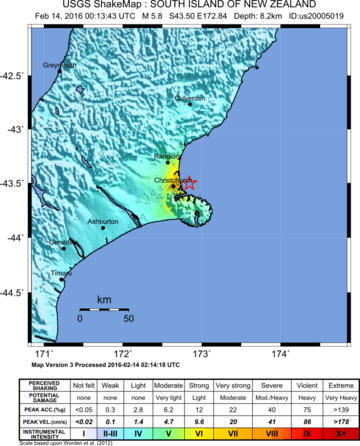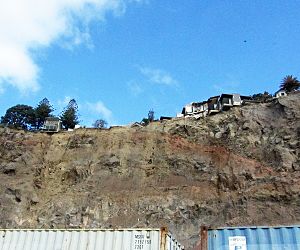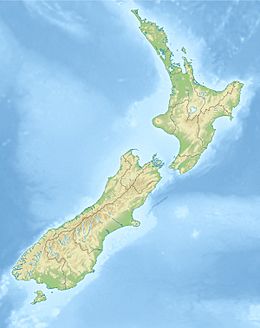2016 Christchurch earthquake facts for kids

Map showing the epicentre of the earthquake
|
|
| UTC time | 2016-02-14 00:13:44 |
|---|---|
| ISC event | 608330826 |
| USGS-ANSS | ComCat |
| Local date | 14 February 2016 |
| Local time | 01:13 PM NZDT (UTC+13:00) |
| Magnitude | 5.7 ML |
| Depth | 8 km (5 mi) |
| Epicenter | 43°30′S 172°50′E / 43.50°S 172.83°E |
| Type | Strike-slip |
| Areas affected | New Zealand |
| Total damage | Building collapse, power outages, rockfall, sinkhole |
| Max. intensity | MM VIII - destructive |
| Peak acceleration | 0.4g |
| Tsunami | No |

The 2016 Valentine's Day earthquake was a strong earthquake that hit Christchurch, New Zealand, on February 14, 2016. It happened at 1:13 PM local time. The earthquake was first measured at 5.9 on the Richter scale, but later changed to 5.7. Its centre was in the sea near New Brighton, about 15 kilometres deep.
This was the first big earthquake in the Christchurch area since May 2012. It was part of a series of earthquakes that began with the 2010 Canterbury earthquake on September 4, 2010.
When the earthquake hit, some cliffs collapsed. This happened at places like Scarborough (including Godley Head and Whitewash Head), Richmond Hill, and Sumner (at a spot called Peacock's Gallop). At Peacock's Gallop, tall stacks of shipping containers were still placed along the road. These containers helped stop rocks from hitting people cycling past. Two surfers were near Whitewash Head when rocks the size of cars fell into the sea around them.
Contents
How the Earthquake Affected Christchurch
The Valentine's Day earthquake caused several problems and changes in Christchurch. Many buildings and public places were checked for safety.
Impact on Shopping Centres
Several large shopping centres, including Westfield Riccarton, Eastgate Mall, The Palms, and Ballantynes, were emptied. They closed so engineers could check if they were safe.
At Northlands Shopping Centre, there was some confusion. Police told some shop owners to leave, but the mall's alarm did not sound. Mall managers told some shopkeepers they might face money penalties if they closed their stores. Even so, nearly 50 shops in the mall closed. This was partly because items had fallen off shelves and blocked the aisles.
A local newspaper, The Press, later criticised how the mall management handled the situation. They said the managers did not understand how serious the event was.
Damage to Historic Buildings and Tram
After the earthquake, seven of the forty old building fronts (called façades) in the central city's New Regent Street were found to be unsafe. These buildings were blocked off for safety. This also stopped the historic tram from running. The tram is a popular attraction and its closure affected businesses that were still open. The tram started working again in May 2016.
Other Effects on the City
The ground became soft and watery in some areas, like Bexley, Parklands, and New Brighton. This is called liquefaction. About 500 homes lost electricity.
The CoCA Art Gallery had just reopened the day before the earthquake, on February 13, 2016. It had been closed since the 2011 Christchurch earthquake. After the Valentine's Day quake, it had to close again. Luckily, not much serious damage was reported in the main part of Christchurch Central City.
There were no reports of anyone being seriously hurt. The St. John Ambulance service closed its emergency centre later that day. The country's main emergency centre in Wellington also stood down. The city's emergency response was then handled by the Christchurch City Council. Some walking tracks in the Port Hills were closed because rocks had fallen. This included the Rapaki Track and the Bridle Path.
How People Felt After the Quake
Experts who study how people think (psychologists) said that people who had lived through the 2011 Christchurch earthquake might feel scared again during aftershocks. This was especially true for those who had lost their homes or friends.
The Canterbury District Health Board (CDHB), a group that manages health services, had been asking for more money for mental health support since the 2011 earthquake. Mental health support helps people deal with their feelings and stress.
Two days after the Valentine's Day earthquake, it was announced that the national health department planned to cut the mental health budget for Canterbury. Other areas were getting more money. The Press newspaper called this situation "disgraceful and distressing." They asked the health minister, Jonathan Coleman, to visit Canterbury and see the situation for himself.
In early March, Minister Coleman announced that more money would be given to Canterbury for mental health. He said the February 2016 earthquake was the reason for this extra help. He explained that when the earthquake hit, he knew it would be a big deal for health services.
Christchurch mayor Lianne Dalziel also shared how she felt during the earthquake. She said it was a shock and that she screamed. She had gotten used to earthquakes and usually didn't mind them, but this one surprised her.


